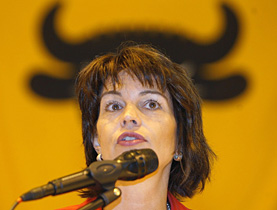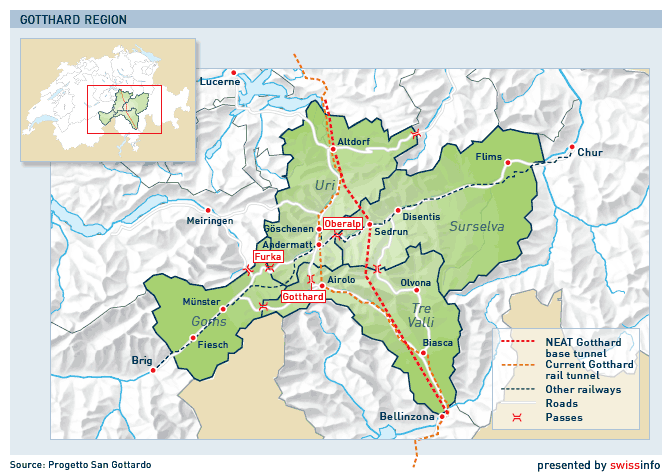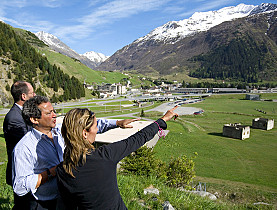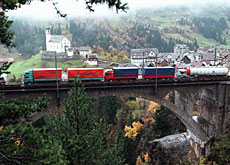Reinvigorating the heart of the Alps

The Gotthard region is laden with myth; as central Europe's main north-south transit route it helped shape Swiss history, but today has become a backwater.
Some 150 representatives from the cantonal parliaments of Graubünden, Ticino, Uri and Valais met in the village of Andermatt on Monday to adopt the San Gottardo Charter, designed to give the region a new impulse.
A meeting where the delegates can be heard chatting in German, Italian and Romansh may not seem the best basis for an ambitious project where cooperation is the watchword.
But Isidor Baumann, head of the Uri government, brushed the language issue aside. “We understand each other very well,” he told the meeting. “We share a similar mentality.”
The charter brings together regions from four different cantons to cooperate in developing the economic, tourism, social and cultural potential of the area as a whole. The aim is to counteract the lack of jobs and the consequent depletion of the population as young people go off elsewhere to find work.
It is being launched under the slogan: The heart of the Alps in the centre of Europe.
Cooperation
“Active cooperation between the mountain cantons is no longer a ‘nice to have’, but a ‘must’,” said Annalise Russi, speaker of the Uri parliament, setting the tone in her opening address.
If cooperation is one of the fundamental principles of the project, another is that implementation should come from the bottom up. Economics Minister Doris Leuthard, in welcoming the project, made clear that the government’s New Regional Policy was designed to create incentives for cantons to get together to improve their competitiveness.
While the central government is ready to help with specialist advice, it is the cantons which bear the responsibility for pushing regional cooperation policies through.
As one delegate pointed out, the region must attract investors, who will only come if they find support in the local communities. A major project which is expected to have a knock-on effect throughout the region is the development of tourism in Andermatt by Egyptian businessman Samih Sawiris.
New Gotthard rail line
Behind the idea for the creation of the Regio San Gottardo is the new Gotthard base tunnel, the NRLA (NEAT in German), currently under construction, and due to open in 2016.
It is well over 100 years since the last mule train and the last post coach laboured over the Gotthard pass, put out of business by the first rail tunnel still in use today. It is nearly 30 years since the road tunnel took away yet more transit traffic from the region. The base tunnel, 56km long, will bypass the area completely.
Surselva in Graubünden hoped that an access shaft to the new line could be transformed into an intermediate station, boosting tourism in this out-of-the-way area.
It was the so-called Porta Alpina which first brought together the regions now involved in the Gottardo project. Although for cost reasons the plan was finally dropped, the idea of cooperation between the partners had taken root.
Baumann takes a positive view of the whole thing. “Perhaps it’s good that major new projects suddenly call into question old activities that have always been taken for granted,” he told swissinfo.
“For example, we now have to start thinking about how to actively bring visitors to the region, because they are no longer obliged to come this way in transit.”
“The NRLA was a wake-up call. And thank goodness for that!”
In any case, the idea fell on fertile ground. For years local organisations had been pushing their own projects.
“Many of the ideas now being worked on are old,” Jean-Daniel Mudry, the San Gottardo project leader, explained.
Unique
Nevertheless, the attempt to create a region from four cantons is unique in Switzerland, and poses its own problems.
There is not only the matter of the three languages, but also the fact that even peripheral regions are used to looking towards their own cantonal capitals, rather than towards their neighbours, since that is where they get their money from for their development.
“We have to get people to see it is worth being involved in the San Gottardo project, because it will help prevent our region from becoming a museum,” Mudry told swissinfo.
“Sustainable development will enable us to go on living here and today sustainable development means more cooperation, and thinking in terms of larger units.”
But he pointed out that it is necessary to work out specific programmes before the project can be sold to the people: they need to know what it will cost and what benefits to expect. That is the next task.
Down to business
The meeting provided the chance to make discoveries about other regions, and to discuss specific ways of cooperating.
In tourism, one of the main sources of income, a start has already been made by promoting the region as a whole on the tourist websites of the individual areas.
But to keep visitors for more than a couple of nights as they pass through, more needs to be done. Specific ways of exploiting the tourism potential are under consideration.
Transport was another issue under discussion. Delegates called for train timetables to be improved to provide better connections, and a better service linking the four regions.
The future of the initiative is open. If successful, it could draw in areas further away from the Gotthard heartland.
The borders are not legally fixed, Mudry said. But there is no question of challenging peoples’ traditional sense of identity with their own cantons.
“We’re not aiming for a St Gotthard canton. That would mean 30 years of war!”
swissinfo, Julia Slater in Andermatt
The regions grouped in the San Gottardo project, are the areas around not only the Gotthard pass, but also the Furka and Oberalp passes, namely:
the Upper Reuss valley and Urserental in Uri
the Goms area in Valais
the Tre Valli in Ticino
Surselva in Graubünden.
The Swiss government is actively promoting regional cooperation in its New Regional Policy.
The Regio San Gottardo project – using the Italian name of the area – is the only regional grouping in Switzerland to cross cantonal borders.
However, several frontier regions have cooperation agreements crossing the national boundary.


In compliance with the JTI standards
More: SWI swissinfo.ch certified by the Journalism Trust Initiative



You can find an overview of ongoing debates with our journalists here. Please join us!
If you want to start a conversation about a topic raised in this article or want to report factual errors, email us at english@swissinfo.ch.